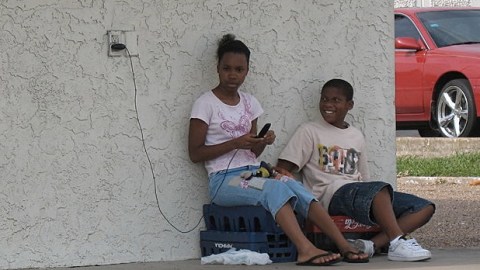The Wealth Gap Between Whites and Blacks

The gap between the rich and the poor has been growing in the United States. The richest 1% of the American population now controls close to 40% of the country’s wealth, while the richest 25% controls a staggering 87% of its wealth. The gap between rich and poor has been growing in part because we’ve changed the tax code in ways that benefit the wealthy, by lowering taxes on investments and inheritances and creating for deductions for mortgages and savings accounts. The result is that after taxes and transfers, wealth in the U.S. is distributed less equally than anywhere else in the developed world. While government policy does have the net effect of redistributing wealth from the rich to poor, the redistributive effect is smaller in the U.S. than in any other developed country—too small to compensate for the fact that it’s easier to make money when you already have money.
Less talked about is another related wealth gap: the one between whites and blacks. According to a report (pdf) by the Institute on Assets and Social Policy, the gap between how much whites own and how much blacks own has been growing too. Between 1984 and 2007, the gap between the median white family’s assets outside of home equity and the median black family’s assets outside of home equity has grown almost five-fold, from $20,000 to $95,000. In 1984 the median white family had $22,000, but by 2007 that number had grown to $100,000. The median black family’s assets grew too, but from $2,000 to just $5,000. Meanwhile 25% of black families have no net assets at all or are in debt. If anything, these numbers actually understate the current gap, because they don’t include home equity. And the recent economic crisis has been particularly hard on blacks, with unemployment almost three times as high among them as among whites.
Part of the explanation for the gap is that many more whites than blacks are among that the increasingly wealthy top 25% of the population. But the striking thing about the report is that even when you control for income levels, black families still have less money in the bank. The median white family earning $30,000 a year has $74,000 in assets. That’s more than five times as much the median black family earning the same amount, which has just $14,000. In fact, the median black family earning more than $50,000 a year has just $18,000 in assets—still much less than white families with substantially smaller incomes. The fact that blacks often have larger and poorer extended families probably accounts for part of the difference. But the report also attributes the difference in part to persistent discrimination in housing, credit and labor markets. Among other things, blacks were at least twice as likely to have to take out high-cost mortgages as whites with similar incomes. “Too many Americans, whites and even some blacks, think that the playing field has indeed leveled,” Marc Morial, president and CEO of the National Urban League, told the Associated Press. Clearly, as he said, it has not.





